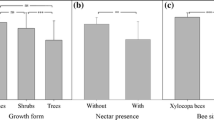Abstract
It has been commonly suggested that ants negatively affect plant pollination, particularly in the tropics. We studied ant–flower–pollinator interactions in a lowland rainforest in Borneo. Frequency and duration of pollinator visits were compared between flowers attended by ants and flowers from which ants were excluded. In all four plant species studied, the activity of ants decreased the rate and/or duration of the pollinators’ floral visits. For this and other reasons it is expected that plants repel ants from flowers during anthesis. We tested this prediction for a different set of plant species in which we observed the behaviour of Dolichoderus thoracicus ants when encountering flowers. In eight out of 18 plant species studied, ants showed a significantly higher rejection rate when they encountered flowers than when they encountered controls. Our results are thus consistent with the hypothesis that ants may negatively affect plant fitness by reduced intensity of pollinator visits and that ants are repelled from flowers of many tropical plant species, although this repellence is clearly not ubiquitous.

Similar content being viewed by others
References
Altshuler DL (1999) Novel interactions of non-pollinating ants with pollinators and fruit consumers in a tropical forest. Oecologia 119:600–606
Beattie AJ, Turnbull CL, Hough T, Jobson S, Knox B (1985) The vulnerability of pollen and fungal spores to ant secretions: evidence and some evolutionary implications. Am J Bot 72:606–614
Benjamini Y, Hochberg Y (1995) Controlling the false discovery rate: a practical and powerful approach to multiple testing. J R Stat Soc Ser B 57:289–300
Blüthgen N, Gebauer G, Fiedler K (2003) Disentangling a rainforest food web using stable isotopes: dietary diversity in a species-rich ant community. Oecologia 137:426–435
Blüthgen N, Gottsberger G, Fiedler K (2004a) Sugar and amino acid composition of ant-attended nectar and honeydew sources from an Australian rainforest. Aust Ecol 29:418–429
Blüthgen N, Stork NE, Fiedler K (2004b) Bottom-up control and co-occurrence in complex communities: honeydew and nectar determine a rainforest ant mosaic. Oikos 106:344–358
Davidson DW (1997) The role of resource imbalances in the evolutionary ecology of tropical arboreal ants. Biol J Linn Soc 61:153–181
Davidson DW, Cook SC, Snelling RR, Chua TH (2003) Explaining the abundance of ants in lowland tropical rainforest canopies. Science 300:969–972
Feinsinger P, Swarm LA (1978) How common are ant-repellent nectars? Biotropica 10:238–239
Fowler HG, Whitford WG (1982) Floral visitation by Chihuahuan Desert ants. J Nat Hist 6:879–881
Galen C (1983) The effects of nectar thieving ants on seedset in floral scent morphs of Polemonium viscosum. Oikos 41:245–249
Galen C (2003) Ants in your plants: effects of nectar-thieves on pollen fertility and seed-siring capacity in the alpine wildflower, Polemonium viscosum. Oikos 101:521–528
Ghazoul J (2001) Can floral repellents pre-empt potential ant–plant conflicts? Ecol Lett 4:295–299
Goitía W, Bosque C, Jaffé K (1992) Interacción hormiga-polinizador en cacao. Turrialba 42:178–186
Guerrant EO, Fiedler PL (1981) Flower defenses against nectar-pilferage by ants. Biotropica 13:25–33
Haber WA, Frankie GW, Baker HG, Baker I, Koptur S (1981) Ants like flower nectar. Biotropica 13:211–214
Harley R (1991) The greasy pole syndrome. In: Huxley CR, Cutler DF (eds) Ant–plant interactions. Oxford University Press, Oxford, pp 430–433
Hölldobler B, Wilson EO (1990) The ants. Belknap Press, Harvard University Press, Cambridge
Jaffé K, Hernandez JV, Goitía W, Osio A, Osborn F, Cerda H, Arab A, Rincones J, Gajardo R, Caraballo L, Andara C, Lopez H (2003) Flower ecology in the neotropics: a flower–ant love–hate relationship. In: Basset Y, Novotny V, Miller S, Kitching R (eds) Arthropods of tropical forests: spatio-temporal dynamics and resource use in the canopy. Cambridge University Press, Cambridge, pp 213–219
Janzen DH (1977) Why don’t ants visit flowers? Biotropica 9:252
Koptur S, Truong N (1998) Facultative ant–plant interactions: nectar sugar preferences of introduced pest ant species in South Florida. Biotropica 30:179–189
Lanza J (1988) Ant preferences for Passiflora nectar mimics that contain amino acids. Biotropica 20:341–344
van der Pijl L (1955) Some remarks on myrmecophytes. Phytomorphology 5:190–200
Stäger R (1931) Über die Einwirkung von Duftstoffen und Pflanzendüften auf Ameisen. Z Wissensch Insektenbiol 26:55–65
Sugiura N, Miyazaki S, Nagaishi S (2006) A supplementary contribution of ants in the pollination of an orchid, Epipactis thunbergii, usually pollinated by hover flies. Plant Syst Evol 258:17–26
Tobin JE (1994) Ants as primary consumers: diet and abundance in the Formicidae. In: Hunt JH, Nalepa CA (eds) Nourishment and evolution in insect societies. Westview Press, Boulder, pp 279–307
Tsuji K, Hasyim A, Nakamura H, Nakamura K (2004) Asian weaver ants, Oecophylla smaragdina, and their repelling of pollinators. Ecol Res 19:669–673
Willmer PG, Stone GN (1997) How aggressive ant guards assist seed-set in Acacia flowers. Nature 388:165–167
Acknowledgements
We thank the Friedrich Drayer Company (Glottertal, Germany) for generously donating tree-climbing equipment, the Economic Planning Unit (Malaysia) and the Danum Valley Management Committee for permission. This work was part of the Royal Society’s South East Asia Rainforest Research Programme. The DAAD is acknowledged for travel support for R.J. and the Danum Valley staff for logistical support.
Author information
Authors and Affiliations
Corresponding author
About this article
Cite this article
Junker, R., Chung, A.Y.C. & Blüthgen, N. Interaction between flowers, ants and pollinators: additional evidence for floral repellence against ants. Ecol Res 22, 665–670 (2007). https://doi.org/10.1007/s11284-006-0306-3
Received:
Accepted:
Published:
Issue Date:
DOI: https://doi.org/10.1007/s11284-006-0306-3




